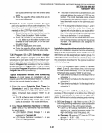
This is used to prevent a user from dialing a
second call when dial tone is returned from a
CO after the outside party disconnects.
l
2: Disable Digit Restriction-Enter 0 in
the
Digit Restrict Code column, next to the port
number to disable digit restriction for the sta-
tion. This allows toll restricted users to dial any
number of digits (i.e., to an external voice mail
device, computer, etc.).
4.103 Station Restrict Code:
The second fea-
ture assigns Toll Restriction to individual station
ports, in addition to previous restrictions. It includes
seven different choices. One of the choices must
be entered for each port. Initialized data assigns 0
or no restrictions to all ports. The seven choices
are explained as follows.
NOTE:
Station restrictions are overridden by CO
lines disabled as defined in
Program 45-2.
If
a station port has appearance of a CO line
with restrictions disabled, the restrictions will
be removed from the station on an individual
CO line basis through
Program 45-Z.
l
0: No Station Toll Restriction-Enter 0
in the
Station Restrict Code column, next to the port
number, to remove toll restrictions from the
station.
l
1: Area CodeToll Restriction-Enter 1
in the
Station Restrict Code column, next to the port
number If the selected station must be re-
stricted from dialing all area codes.
l
2: Area Code Toll Restriction and “0” or “1”
as a 1st or 2nd
Digit-Enter 2 in the Station
Restrict Code column, in the space available
for the port number, if the selected station must
be restricted from dialing all area codes, and 0
or
1
when used as a first or second digit. This
restriction prevents the station from making
any long distance calls or operator-assisted
calls, in addition to outgoing calls outside the
home area code. In applicable areas, this
prevents long distance office codes from being
dialed (if l+NNX).
l
3: Class 1 Toll Restriction-Enter 3
in the
Station Restrict Code column in the space
provided for the port number, if the selected
PROGRAMMING PROCEDURES-INSTRUCTIONS/SYSTEM RECORDS
SECTION 200-096-302
FEBRUARY 1991
station will be assigned to the Class 1 level of
restriction. Class 1 area and office code re-
strictions are defined in
Program 46,
a’nd ex-
ception office code tables in 46-10.
l
4: Class 2 Toll Restriction-Enter 4
in the
Station Restrict Code column in the space
provided for the port number, if the selected
station will be assigned to the Class 2 level of
restriction. Class 2 area and office code re-
strictions are defined in
Program
46, and ex-
ception office code tables in 46-20.
l
5: Class 3 Toll Restriction-Enter 5
in the
Station Restrict Code column in the space
provided for the port number, if the selected
station will be assigned to the Class 3 level of
restriction. Class 3 area and office code re-
strictions are defined in
Program
46, and ex-
ception office code tables in 46-30.
l
6: Class 4 Toll Restriction-Enter 6
in the
Station Restrict Code column in the space
provided for the port number, if the selected
station will be assigned to the Class 4 level of
restriction. Class 4 area and office code re-
strictions are defined in
Program
46, and ex-
ception office code tables in 46-40.
5 LEAST COST ROUTING
5.01
The following provides the programmer an
overview of the Least Cost Routing feature and
step-by-step instructions to fill in the Least Cost
Routing System Record Sheets.
6 LEAST COST ROUTING OVERVIEW
6.00 Definition
6.01
The Least Cost Routing (LCR) feature en-
ables the system to automatically route each out-
going voice and data call over common carriers
and selected CO lines. The customer chooses
these lines for the specific time of day, and for
system users with varying priorities. If the system
is programmed properly, LCR can select the most
economical route, helping save money. If the
best routes are unavailable, users with priority
can access more expensive outgoing routes.
Several elements of LCR must be defined in
programming.
2-25


















